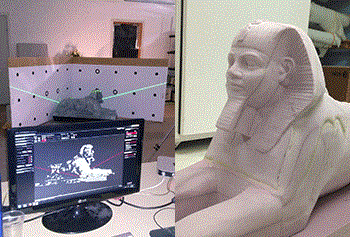Students Returning Historic Statues to Cemetery

10/01/2013
By Julia Gavin
After protecting the receiving tomb at the Lowell Cemetery for a century, two 120-pound bronze sphinxes went missing in the 1970s. One was recovered, and has been kept in safekeeping ever since. With the help of engineering students, there’s hope the sphinxes will take their rightful places again.
The tomb was built for the young son of Freeman Ballard Shedd, a cologne magnate, in 1890, keeping the departed safe for many winters until internments could resume in the spring. Mechanical engineering Asst. Prof. Christopher Hansen became intrigued by the sphinxes’ story on a tour of the cemetery. He heard that the cemetery would like to replace the missing statues with replicas that are easier to maintain and protect, a project perfect for a senior engineering capstone experience. Five students agreed and began working on a way to make a mold and copy the sphinx.
Due to the surviving sphinx’s vulnerability, it couldn’t be moved, directly cast or heavily touched. The students, Evan Warniers, Kyle Tweed, Kathleen Laliberte, Cedric Horeau and Mariska Harbachuck, spent many hours researching materials, building equipment and scanning the sculpture with beams of light to import its general shape and finer details into an imaging program.
“We used the David laser scanner package and supplemental packages to take individual surfaces and combine them into a full 3D object,” says Horeau, who took the lead on scanning and modeling. His favorite part of the project was scanning real objects such as the sphinx and rebuilding them from the surface scans into a model using computer software. The students built a spinning stand for the statue and scanned it multiple times with 15 degree turns to capture a full picture.
“It was cool to see a real object come on to the screen and be able to manipulate it, cut things out or move pieces around to where we wanted them digitally,” says Horeau. “If I can make that part of my career it would be great.”
While the team planned how to replicate the original sphinx, Tweed discovered that they were working from a copy. Tweed researched the sphinx and its tomb for an art appreciation course and traced an inscription on its side that reads “THEIBAUT FRERES Fondeurs –PARIS.” back to the foundry where it was made. He also connected the sphinx’s distinctive hieroglyphics and facial features to the Great Sphinx of Tanis, which was discovered in 1825 and purchased by the Louvre a year later.
Tweed suggests that the then widely known sphinx, may have inspired Shedd’s Egyptian design for the tomb and statue choice. Sphinxes were considered guardians of holy places, so Shedd may have wanted the famous statue to protect Lowell’s departed.
“The opportunity to work with cutting-edge products and materials such as 3D scanning and composites drew me to the project, but the rich history of Lowell and the opportunity to help restore a piece of city history was also appealing,” says Tweed. ”Researching the origins of the Lowell Cemetery sphinx enhanced my appreciation of the artwork, and it’s nice to finally know its history after working with it for four months.”
Real Experiences in Engineering
Along with learning new software and the opportunity to help the community, the project gave the team real engineering problems to tackle. Project limitations, material failures and time constraints gave them a realistic look at working as an engineer.
“I learned that real engineering problems do not have one known answer,” says Laliberte, who worked on the scanning equipment. “There will be many issues along the way that require logistical tactics. I gained confidence in tackling an unknown subject and learning through extensive research, trial-and-error and a little patience.”
Hansen, who has worked with students on other community service projects, says the team was devoted to the project, even on the tough nights when nothing worked and the sphinx seemed impossible to revive. He worked with them to step back from their frustration, identify the problem to be solved and find new ways to approach the issues before giving up.
“The students got to see common aspects of real world problems and that made them adapt to the challenges, which they handled well,” Hansen says.
With only a few months to work and graduation looming, the students spent many hours — even a snow day off from school — testing, scanning, digitally rebuilding and finally milling a new sphinx from foam. They also tested different composites to build a mold from the foam sculpture and discussed next steps including working with art students to recreate the sphinx’s patina at the end of the project.
While the sphinxes haven’t made their return to the Lowell Cemetery yet, Hansen is confident that the project will be completed.
